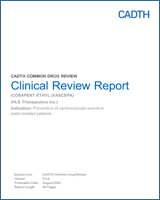Efficacy
Based on the REDUCE-IT study, icosapent ethyl resulted in a reduction in the composite outcome of CV death, non-fatal MI, non-fatal stroke, coronary revascularization, and hospitalization for unstable angina. Overall, 22% of patients in the placebo group and 17.2% of those taking icosapent ethyl (absolute difference of 4.8%) experienced at least one component of the composite outcome. Icosapent ethyl was associated with a 24.8% relative risk reduction, which the clinical experts consulted by CADTH indicated is clinically meaningful. The clinical experts noted, however, that the magnitude of benefit with icosapent ethyl may vary in clinical practice settings outside of the controlled trial with greater variation in treatment adherence and statin dosage, and a more heterogeneous population than that in the trials, as examples. Results for the individual components of the composite primary outcome did not clearly suggest that one component dominated in driving the treatment effect of icosapent ethyl.
Subgroup analyses in REDUCE-IT suggested a potential difference in risk reduction for the composite primary outcome with icosapent ethyl in patients with established CVD (HR versus placebo 0.726; 95% CI, 0.650 to 0.810) and those at high risk for CVD (HR versus placebo 0.876; 95% CI, 0.700 to 1.095). The test for interaction was statistically significant at the pre-specified alpha level. The imbalance in the percentage of patients categorized as having established CVD (70%) versus those at risk (30%) may, in part, explain this result.
Although icosapent ethyl reduced CV mortality events (4.3% event rate in the icosapent ethyl group versus 5.2% in the placebo group), non-fatal CV events, and coronary revascularization, the study revealed no significant difference in all-cause mortality, or hospitalizations due to arrhythmia or congestive heart failure. The lack of a statistically significant effect on all-cause mortality is not surprising, at least in part because of the sample size and the duration of REDUCE-IT, both of which were likely insufficient to evaluate this outcome.
In both studies, blood levels of TG, LDL-c, HDL-c, and hsCRP changed from baseline in the intervention group, and this change was larger in the icosapent ethyl group than in the placebo group. The complete mechanism of action of icosapent ethyl in the studied populations remains unclear, but it appears, in part, to positively impact blood lipid profiles.
The clinical significance of this treatment effect still needs to be evaluated to understand its relationship to clinically important outcomes.
It is difficult to determine the clinical value added of icosapent ethyl, given that the primary efficacy data comes from a single — albeit relatively large — randomized controlled trial versus placebo. No studies were available comparing icosapent ethyl with relevant comparators considered for this review: fibrates, ezetimibe, niacin, and omega-3 fatty acid preparations. Studies with these other drugs that also lower TG levels have not demonstrated a benefit as add-on treatment in the patient population with residual risk and in other groups of patients.17,30–32 The low dose or the low ratio of EPA to DHA in some of the omega-3 fatty acids studied may be the reason previous studies showed no effect. Yet, the absence of head-to-head or indirect comparisons between icosapent ethyl and comparators of interest for this review means the comparative effects are unknown.
Furthermore, the results for efficacy may not be applicable to patients with characteristics outside the inclusion criteria of the REDUCE-IT trial. Indeed, the clinical experts consulted by CADTH noted that use of icosapent ethyl will be targeted to the studied population as add-on to optimized statin treatment. The real-world benefit of icosapent ethyl may be less than observed in the seemingly selected population of REDUCE-IT (which is a common trait of randomized controlled trials of drugs for CV conditions). It is important to note the concern generated by the increased levels of TG and hsCRP observed in the placebo arm of the REDUCE-IT trial. Although the effect of this increase on the results of REDUCE-IT is still uncertain, as no effects of this difference were observed in post hoc analyses, it is worth considering when the drug is used in clinical settings and when adherence to treatment may not be complete.
No input from patient groups was received for this review. However, based on input provided for previous CADTH CDR reviews on drugs for the prevention or treatment of CVD, it is likely that outcomes of interest to patients (with exception of health-related quality of life) were evaluated in REDUCE-IT. Past patient-group input, as well as input from the clinical experts consultations, suggests that the efficacy results of REDUCE-IT would fill some of the unmet needs for an effective therapy in patients with residual CV risk despite statin therapy.
Harms
The rates of adverse events were low and generally similar between the trial groups. Some differences, however, are important to mention.
Atrial fibrillation, constipation, peripheral edema, and serious adverse bleeding were more frequent in the icosapent ethyl group than in the placebo group. The higher frequencies of bleeding and of hospitalization for atrial fibrillation or flutter in the icosapent ethyl group versus placebo were considered important by the clinical experts participating in this review. This was considered a safety signal that should be monitored in clinical practice. The incidence of bleeding was greater in patients receiving concomitant antithrombotic medications, such as Aspirin, clopidogrel, or warfarin. However, even with these increased risks of bleeding and atrial fibrillation, the undesirable events are likely outweighed by the reduction of CV risk in high-risk patients with elevated serum TG levels despite treatment with a statin.

